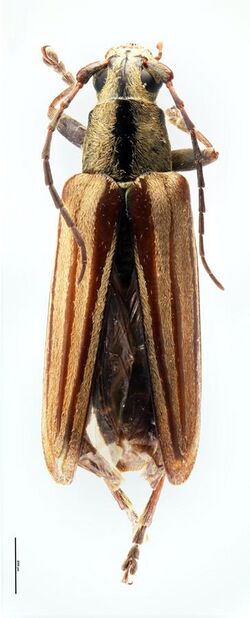Biology:Coptomma marrisi
| Coptomma marrisi | |
|---|---|

| |
| Holotype | |
| Scientific classification | |
| Domain: | Eukaryota |
| Kingdom: | Animalia |
| Phylum: | Arthropoda |
| Class: | Insecta |
| Order: | Coleoptera |
| Infraorder: | Cucujiformia |
| Family: | Cerambycidae |
| Genus: | Coptomma |
| Species: | C. marrisi
|
| Binomial name | |
| Coptomma marrisi Song & Wang, 2003
| |
Coptomma marrisi is a species of longhorn beetle only known from Great Island in the Three Kings Islands, New Zealand.
Taxonomy
In a revision of the genus Coptomma, Deping Song and Qiao Wang of Massey University synonymised two species and described a new one, Coptomma marrisi, from a male and female collected by Lincoln University entomologist John Marris on an expedition to the Three Kings Islands in 1996. The holotype and paratype were deposited in the Lincoln University Entomology Research Collection. One previous specimen had been collected in 1970 by a DSIR Entomology Division expedition, and lodged in the New Zealand Arthropod Collection.[1]
Song and Wang chose the name marrisi to honour the collector of the holotype, John Marris.[1]
Description
Coptomma marrisi most resembles the striped longhorn beetle C. lineatum, which is widely distributed through mainland New Zealand. It differs in having a wide frons, a hairless stripe on the thorax, and reddish-brown femurs. Its body is just over 15 mm (females) and 11–12 mm (males), and is reddish-brown with four long yellow stripes on each wing cover.[1]
Habitat and distribution
This species is known only from Great Island in the Three Kings Islands, and like the Three Kings click beetle Amychus manawatawhi, it may have evolved and persisted on Great Island, rather than being a remnant of a formerly-widespread species. The Three Kings have been isolated from mainland since the Miocene, and are rich in endemic species.[2]
Adult beetles were collected on coastal plants, particularly Kunzea, in December. Nothing else is known about their possible host.[1]
Conservation
This species has not been assessed by the Department of Conservation for possible threats; other species on the Three Kings have been classed as "Naturally Uncommon".[3]
References
| Wikimedia Commons has media related to Coptomma marrisi. |
- ↑ 1.0 1.1 1.2 1.3 Song, Deping; Wang, Qiao (2003). "Systematics of the longicorn beetle genus Coptomma Newman (Coleoptera : Cerambycidae : Cerambycinae)" (in en). Invertebrate Systematics 17 (3): 429–447. doi:10.1071/IT01023. ISSN 1445-5226. http://www.publish.csiro.au/?paper=IT01023.
- ↑ Marris, John W. M.; Johnson, Paul J. (2010). "A revision of the New Zealand click beetle genus Amychus Pascoe 1876 (Coleoptera: Elateridae: Denticollinae) with a description of a new species from the Three Kings Islands". Zootaxa 2331: 35–56. https://www.researchgate.net/publication/239529303. Retrieved 2016-05-29.
- ↑ McGuiness, C.A. "The Conservation Requirements of New Zealand's Nationally Threatened Invertebrates". Department of Conservation. http://www.doc.govt.nz/Documents/science-and-technical/tsop20d.pdf.
Wikidata ☰ Q14835792 entry
 |



